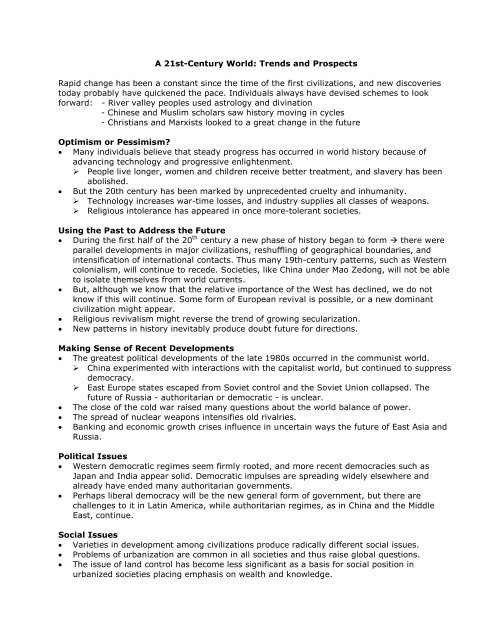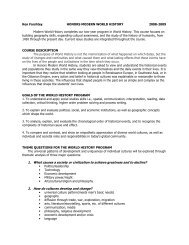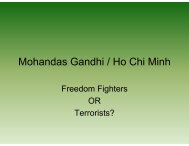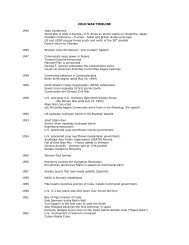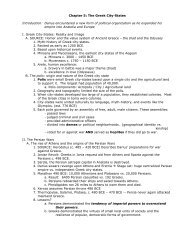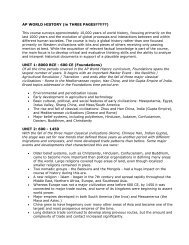A 21st-Century World: Trends and Prospects Rapid change has ...
A 21st-Century World: Trends and Prospects Rapid change has ...
A 21st-Century World: Trends and Prospects Rapid change has ...
You also want an ePaper? Increase the reach of your titles
YUMPU automatically turns print PDFs into web optimized ePapers that Google loves.
A <strong>21st</strong>-<strong>Century</strong> <strong>World</strong>: <strong>Trends</strong> <strong>and</strong> <strong>Prospects</strong><strong>Rapid</strong> <strong>change</strong> <strong>has</strong> been a constant since the time of the first civilizations, <strong>and</strong> new discoveriestoday probably have quickened the pace. Individuals always have devised schemes to lookforward: - River valley peoples used astrology <strong>and</strong> divination- Chinese <strong>and</strong> Muslim scholars saw history moving in cycles- Christians <strong>and</strong> Marxists looked to a great <strong>change</strong> in the futureOptimism or Pessimism? Many individuals believe that steady progress <strong>has</strong> occurred in world history because ofadvancing technology <strong>and</strong> progressive enlightenment.‣ People live longer, women <strong>and</strong> children receive better treatment, <strong>and</strong> slavery <strong>has</strong> beenabolished. But the 20th century <strong>has</strong> been marked by unprecedented cruelty <strong>and</strong> inhumanity.‣ Technology increases war-time losses, <strong>and</strong> industry supplies all classes of weapons.‣ Religious intolerance <strong>has</strong> appeared in once more-tolerant societies.Using the Past to Address the Future During the first half of the 20 th century a new p<strong>has</strong>e of history began to form there wereparallel developments in major civilizations, reshuffling of geographical boundaries, <strong>and</strong>intensification of international contacts. Thus many 19th-century patterns, such as Westerncolonialism, will continue to recede. Societies, like China under Mao Zedong, will not be ableto isolate themselves from world currents. But, although we know that the relative importance of the West <strong>has</strong> declined, we do notknow if this will continue. Some form of European revival is possible, or a new dominantcivilization might appear. Religious revivalism might reverse the trend of growing secularization. New patterns in history inevitably produce doubt future for directions.Making Sense of Recent Developments The greatest political developments of the late 1980s occurred in the communist world.‣ China experimented with interactions with the capitalist world, but continued to suppressdemocracy.‣ East Europe states escaped from Soviet control <strong>and</strong> the Soviet Union collapsed. Thefuture of Russia - authoritarian or democratic - is unclear. The close of the cold war raised many questions about the world balance of power. The spread of nuclear weapons intensifies old rivalries. Banking <strong>and</strong> economic growth crises influence in uncertain ways the future of East Asia <strong>and</strong>Russia.Political Issues Western democratic regimes seem firmly rooted, <strong>and</strong> more recent democracies such asJapan <strong>and</strong> India appear solid. Democratic impulses are spreading widely elsewhere <strong>and</strong>already have ended many authoritarian governments. Perhaps liberal democracy will be the new general form of government, but there arechallenges to it in Latin America, while authoritarian regimes, as in China <strong>and</strong> the MiddleEast, continue.Social Issues Varieties in development among civilizations produce radically different social issues. Problems of urbanization are common in all societies <strong>and</strong> thus raise global questions. The issue of l<strong>and</strong> control <strong>has</strong> become less significant as a basis for social position inurbanized societies placing emp<strong>has</strong>is on wealth <strong>and</strong> knowledge.
Cultural Issues A path to worldwide homogeneity <strong>has</strong> been caused by the adoption of Western culturalvalues, consumer goods, <strong>and</strong> the English language. Separate civilizations keep their own basic forms, but the friction between modernity <strong>and</strong>tradition is constant. Perhaps the trend will result in greater international underst<strong>and</strong>ing.Another issue is the effect of industrialization on the arts. A focus on science <strong>and</strong> technologymay push local arts <strong>and</strong> rich popular traditions to the periphery.Economic Issues Contemporary economic divisions are more complex than the old dichotomy betweenindustrial <strong>and</strong> developing nations sharp disparities of development occur within nations. Economic imbalances help to explain the unresolved problem of the international drug trade.The movement of peoples seeking better economic <strong>and</strong> social conditions <strong>has</strong> mixed peoplesin unprecedented ways <strong>and</strong> created much tension.<strong>World</strong> History Themes:Even though rigid frameworks have declined, inequality continues in contemporarysociety. The most troubling instance of inequality at the end of the 20th centuryinvolved disparities in earnings <strong>and</strong> living-st<strong>and</strong>ards. Gaps increased during 1990s.Environmental degradation remained important because of the effects of exp<strong>and</strong>ingpopulations <strong>and</strong> industrialization. Many industrial societies are working to improvesuch conditions.The Quest for Separate Identities - The formation of larger aggregates amongpeoples never <strong>has</strong> produced stability. Units, whatever the size, constantly fragment.In the 1980s dem<strong>and</strong>s for ethnic autonomy emp<strong>has</strong>ized the breakdown process evenin small regions. No major pattern of modernization <strong>has</strong> yet obliterated keyboundaries among major civilizations.The Forces of International Integration - Previous forces in world history hadpromoted transformations within separate civilizations. This may be changing ascrosscutting forces now push to internationalization as transportation <strong>and</strong>communications systems bring societies closer together. There are now internationalartistic styles, while Western fads <strong>and</strong> fashions influence the daily lives of ordinarypeople. The spread of scientific knowledge among elites cuts boundaries in waysnever achieved by religions. For the present, however, separate civilizations remainvery much alive.


